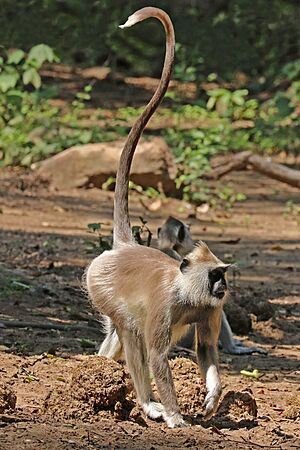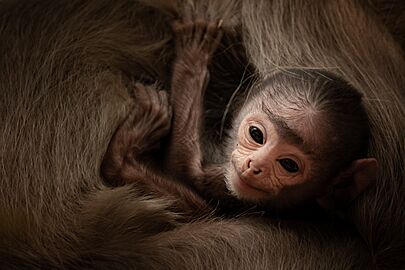Tufted gray langur facts for kids
Quick facts for kids Tufted gray langur |
|
|---|---|
 |
|
| in Chinnar Wildlife Sanctuary, Kerala, India | |
| Conservation status | |
| Scientific classification | |
| Genus: |
Semnopithecus
|
| Species: |
priam
|
 |
|
| Tufted gray langur range | |
The tufted gray langur (Semnopithecus priam), also known as the Madras gray langur, is a type of Old World monkey. Like other gray langurs, it mainly eats leaves. You can find this monkey in southeastern India and Sri Lanka. It's one of three Semnopithecus species named after characters from the ancient story The Iliad. In the Sinhala language, it's called හැලි වදුරා (Heli wandura).
Contents
What is a Tufted Gray Langur?
The tufted gray langur is a fascinating monkey. It belongs to a group of monkeys known for eating a lot of leaves. These langurs are found in two main areas. One group lives in India, and the other lives in Sri Lanka.
Different Types of Tufted Gray Langurs
There are two types, or subspecies, of the tufted gray langur:
- Semnopithecus priam priam: This subspecies lives in India.
- Semnopithecus priam thersites: This subspecies lives in Sri Lanka.
Scientists have different ideas about how these two types became separate. They think that changes in the land, like land bridges forming, might have played a role. This allowed the monkeys to move between India and Sri Lanka a long time ago.
How Big Are Tufted Gray Langurs?
Tufted gray langurs are medium-sized monkeys. Males are usually bigger than females.
Here are some average measurements:
- Head to body length: 55 to 80 centimeters (22 to 31 inches)
- Tail length: 75 to 90 centimeters (30 to 35 inches)
- Weight of an adult: 11 to 20 kilograms (24 to 44 pounds)
The langurs in India are a bit larger than those in Sri Lanka. Even so, the tufted gray langur is the biggest native monkey in Sri Lanka.
What Do They Look Like?
These langurs have gray to brownish-gray fur on their backs. Their fur gets darker as they get older. Their undersides are a lighter gray color. They have a short, whitish beard and sideburns.
A special feature is the hair on their head. It forms a clear, pointed tuft or crest. This tuft meets at a central point, which is how they got their name "tufted." They also have black eyebrows that stick out.
Where Do Tufted Gray Langurs Live?
In Sri Lanka, you can find tufted gray langurs in dry forests. They also live close to people in towns and villages. Many groups of these monkeys live in important historical places. These include Polonnaruwa, Dambulla, Anuradhapura, and Sigiriya. You can also find them in the southern parts of the island. Places like Hambantota, Yala National Park, and Tissamaharama are home to them.
What Do Tufted Gray Langurs Do?
Tufted gray langurs are generally shy animals. They spend some time in trees (arboreal) and some time on the ground (semi-terrestrial). They are active during the day (diurnal). They often come down to the ground when they feel safe.
Unlike some other monkeys that stay in the treetops, these langurs are common in cities. You might see them in gardens or in large fruit trees. They enjoy trees like mango (Mangifera indica) and jackfruit (Artocarpus heterophyllus).
What Do Tufted Gray Langurs Eat?
Tufted gray langurs mostly eat plants. They love to eat almost anything vegetarian. They are known to eat fruits and seeds. Langurs prefer drier, fibrous fruits rather than very juicy ones.
Some of the leaves they eat include Drypetes sepiaria and Ficus microcarpa. They also eat fruits and seeds from plants like Hydnocarpus venenata. Sometimes, groups of langurs can be seen near water. Here, they feed on seeds from water lilies (Nelumbo nucifera).
When other foods are scarce, they might eat insects or evergreen leaves. They only eat tree bark if there is no other food available. Langurs sometimes eat plants that contain a substance called strychnine. To help with this, they often eat gum from the Sterculia urens tree. This gum helps to balance the effects of the plant.
Who Hunts Tufted Gray Langurs?
The main hunters of tufted gray langurs are leopards and black eagles. Younger langurs and sub-adults can also be hunted by other animals. These include tigers, dholes (wild dogs), gray wolves, mugger crocodiles, and Indian rock pythons.
Tufted Gray Langur Behavior and Life Cycle
Tufted gray langurs tend to stay in their home areas. This is called being philopatric. A single group, or troop, can have about 20 to 50 monkeys. Large troops are led by both male and female langurs. Smaller troops are usually led by one main male, called an alpha male.
Reproduction and Young
A female langur usually gives birth to one baby. Very rarely, she might have twins. The pregnancy lasts for about six months. After birth, the baby stays close to its mother for about three months. The mother provides all the food and protection the baby needs.
Younger males and other males in the troop spend their time looking for food. They also watch out for rival alpha males from other groups. They help protect their own troop. Females spend their time feeding, grooming, and playing with their young.
Communication and Teamwork
Tufted gray langurs communicate in many ways. They use barks, grunts, whoops, whistles, and howls. A cough-like sound means there is danger. A whistling sound means they have lost contact with their group.
These monkeys have excellent eyesight. They often sit high in trees, which helps them spot predators easily. Researchers have noticed that langurs often sit near groups of spotted deer. The langurs will warn the deer if a predator is coming. The langurs also drop fruit from tall trees for the deer to eat. In return, the deer have a great sense of smell. They can detect predators early and warn the langurs. It's a great example of teamwork in nature!
Protecting Tufted Gray Langurs
The tufted gray langur is listed as a "Near Threatened" species. This means their numbers have been going down in recent years. Hunting and habitat destruction are big reasons for this decline. Some people in parts of Sri Lanka unfortunately hunt langurs for their meat. Very few are captured to be kept as pets.
Many conservation projects are working to protect these monkeys. These projects are happening in forests and wildlife sanctuaries in both Sri Lanka and India. Both subspecies, thersites and priam, are listed as "Near Threatened."







